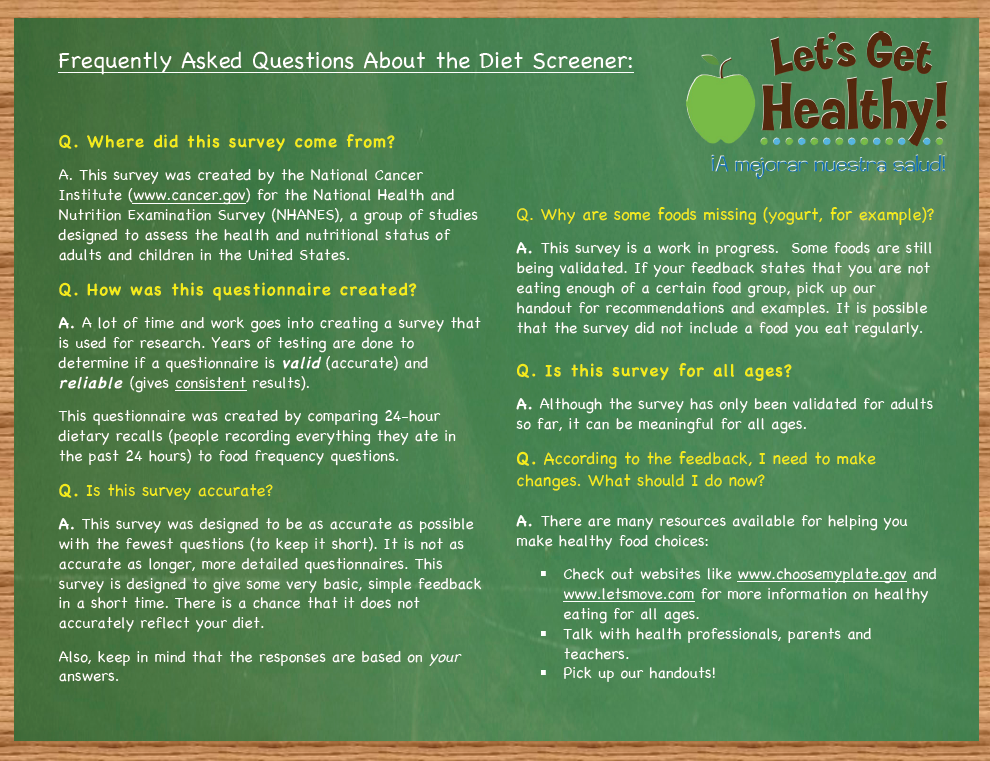Diet
 What is it?
What is it?
The diet station estimates what a person is eating using a short computerized survey. Individuals receive tailored feedback based on their answers to these questions, their age, and gender.
How is it measured?
There are many ways to measure diet, including food diaries (recorded over many weeks) to hour-long surveys. At our events, we use what is called a diet screener. These screeners have been developed to be comparable to these longer methods but are much shorter. This process is called validation. As a result, answers to a few questions can provide an estimation of an individual’s diet. We have used two diet screeners over the years.

Currently:
We use the National Cancer Institute’s Dietary Screener Questionnaire, developed and validated in the National Health and Nutritional Examination Survey (NHANES) for 2009-2010. This diet screener (used by our program from Sept 2012-present) calculates intake of fruit & vegetables, dairy, vitamin D, whole grains, fiber, added sugars and sugary beverage consumption using a computerized version of the NCI/NHANES 2009-2010 Dietary screener from the National Cancer Institute. This computerized self-administered questionnaire contains 26 items and calculates intake of fruits & vegetables, added sugars, added sugars from sugar-sweetened beverages, dairy, calcium, whole grains, fiber, red meat and processed meat. Tailored feedback is provided on these measures, with additional educational handouts provided about whole grains, fiber, dairy, added sugar, fruits & vegetables and overall diet. Check out our frequently asked questions for this station. This station is available for the following audience and takes approximately:
- Adults (English, Spanish) – 5-7 minutes
- Kids (English, Spanish) – 5-7 minutes
Previously: From Summer 2007-August 2012, we used the Block Food Screeners for Adults and Children.
Block Dietary Fat Screener (Adult) – This brief computerized screening tool includes 17 questions, and takes 5 minutes to complete. It was designed to rank individuals with regard to their usual fat intake. Data collected using this form also may be analyzed using prediction equations to generate point estimates of total fat (grams), saturated fat (grams), percent calories from fat, and cholesterol (mg). Portion sizes are not asked. Paper and pencil version can be viewed here: http://www.nutritionquest.com/wellness/free-assessment-tools-for-individuals/fat-intake-screener/ (validated by Block et al., 2000)
Block Fruit/Vegetable/Fiber Screener (Adult) – This brief computerized screening tool includes 7 questions about fruit and vegetable intake and 3 questions about foods high in fiber. It takes about 5 minutes to complete. It ranks individuals with regard to their usual intake of fruits and vegetables. Data collected using this form also may be analyzed using prediction equations to generate point estimates of total fruit/vegetable servings, Vitamin C (mg), magnesium (mg), potassium (mg), and dietary fiber (mg). Portion sizes are not asked. Spanish version also available.
Block Food Screeners for Ages 2-17 2007 (Kids) – The screener asks about food intake over the prior week using 31 items generally representing fruit and fruit juices, vegetables, potatoes (including French fries), whole grains, meat/poultry/fish, dairy, legumes, saturated fat, and “added sugars” (in sweetened cereals, soft drinks, and sweets). Intake of sugary beverages was assessed as well as caffeinated energy drinks (this question was added by our program). Individual portion sizes were asked. This survey can be used to calculate glycemic load and glycemic index. A secondary analysis produces estimates for intake of sugary beverages (both kcal and frequency). Individual portion sizes are asked. This questionnaire was designed for self-administration by children with the assistance of parent or caregiver, as needed. This screener take about 10-12 minutes to complete. As of August 2012, this screener was not yet validated.
Tailored feedback for the kids’ screener was provided based on 2010 USDA recommendations and additional information provided comparison of reported intake in standardized servings to recommended intake of fruits and vegetables, sugar-sweetened beverages (including energy drinks), and fat. The feedback strategy was developed to reflect preferences expressed during focus groups with middle school children on how this age group would like to learn about dietary information.
How we determined the categories?
Dietary recommendations vary based age and gender.
For the NCI/NHANES diet screener:
Fruit & Vegetable Intake (cups)
| Age Range (years) | Male | Female |
|---|---|---|
| 2-3 | 2 | 2 |
| 4-8 | 2.5 | 2.5 |
| 9-13 | 4 | 3.5 |
| 14-18 | 5 | 4 |
| 19-30 | 5 | 4.5 |
| 31-50 | 5 | 4 |
| 51+ | 4.5 | 3.5 |
Dairy Intake (cups)
| Age Range (years) | Male | Female |
|---|---|---|
| 2-3 | 2 | 2 |
| 4-8 | 2.5 | 2.5 |
| 9-13 | 3 | 3 |
| 14-18 | 3 | 3 |
| 19-30 | 3 | 3 |
| 31-50 | 3 | 3 |
| 51+ | 3 | 3 |
Added Sugars (teaspoons)
| Age Range (years) | Male | Female |
|---|---|---|
| All | Less than 9 | Less than 6 |
Where to get more information…
ChooseMyPlate.gov is a beautiful website from USDA that can help you learn more about what you’re eating. They have food tracking programs, healthy menu planning tips, weight management advice, and more.
You can also get a personalized, in depth look at the foods you’re eating on the USDA’s food and activity tracker website: https://www.supertracker.usda.gov/default.aspx
Research Bibliography
Block G, Gillespie C. Rosenbaum EH, Jenson C. A rapid food screener to assess fat and fruit and vegetable intake. Am J Prev Med. 2000; 18(4):284-288.
USDA US Department of Agriculture and Department of Health and Human Services (December 2010.) Dietary Guidelines for Americans, 2010. . 7th Edition ed.]. Washington, DC: U.S. Government Printing Office.
About the NHANES 2009-2010 Dietary screener (http://riskfactor.cancer.gov/studies/nhanes/dietscreen/). Their validation work is extensive and ongoing. For a current list, please see: http://riskfactor.cancer.gov/studies/nhanes/dietscreen/evaluation.html



